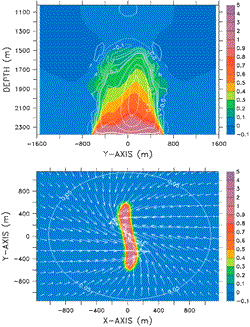| |
Event
Plumes :
The
initial rise of a hydrothermal plume from a line segment source--results
from a three-dimensional numerical model (Abstract)
Problem
Description:
Observations
have shown that magmatic events at the sea floor can suddenly and quickly
release large quantities of heat to the ocean. The resulting mega- or
events plumes are large, rotating inclusion of water hundreds of meters
thick, tens of kilometers in diameters, centered hundreds of meters above
the sea floor. Their presence is detectable by their temperature, particle,
and trace metal signatures. The initial rise and development of megaplumes
have been studied using several variants of the numerical model Hot_Cross.
Since crustal fracturing and heat release during the event is typically
along a linear segment, the study addresses the circulation and plume
development from a line segment source.
 |
a)
Side view of a model megaplume's thermal anomalies midway along
the plume's line-source length. Line contours are vertical velocity
isopleths in m/s.
b) Plan view of the plume 100 m above the sea floor. Inflow velocities
are presented by vectors. The single contour represents the 0.05
m/s horizontal speed isopleth. Twisting of plume and vectors is
caused by the Earth's rotation.
click
for larger view
FLI
Animation (0.33 mb)
mov
Animation (0.28 mb)
|
|
|

